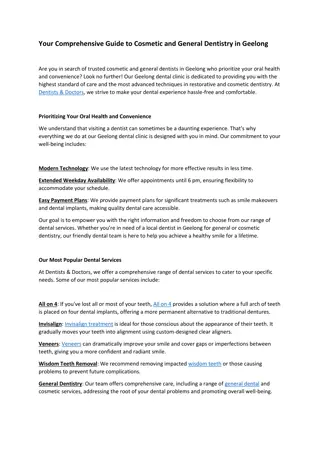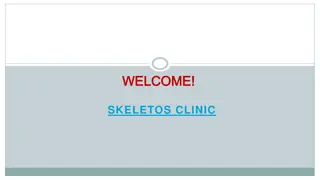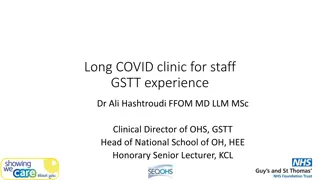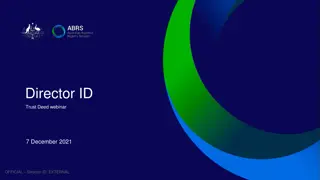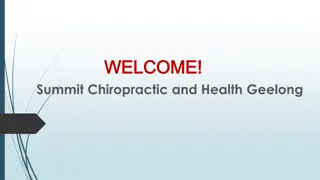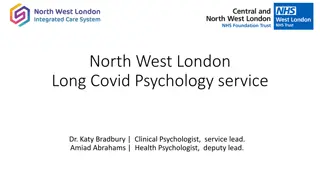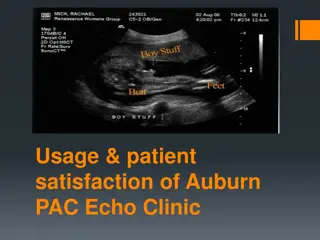Insights from Geelong Long Covid Clinic's Director Dr. Bernard Shiu - RACGP Webinar 16/10/2023
Geelong Long Covid Clinic, led by Dr. Bernard Shiu, offers a multidisciplinary approach to treating long Covid patients with a diverse team of specialists. Established in June 2022, the clinic has seen over 300 patients and utilizes a funding model combining Medicare support and patient co-payments. The clinic's consultation flow involves referrals to hospitalists, initial GP consultations, rehabilitation by allied health professionals, appropriate investigations, monitoring, and treatment initiation. Data on gender and age distributions, referral sources, distance traveled for care, and common symptoms presented provide valuable insights into the clinic's operations and patient demographics.
- Geelong Long Covid Clinic
- Dr. Bernard Shiu
- Multidisciplinary Care
- Patient Demographics
- Long Covid Treatment
Download Presentation

Please find below an Image/Link to download the presentation.
The content on the website is provided AS IS for your information and personal use only. It may not be sold, licensed, or shared on other websites without obtaining consent from the author. Download presentation by click this link. If you encounter any issues during the download, it is possible that the publisher has removed the file from their server.
E N D
Presentation Transcript
Long COVID Update Dr Bernard Shiu Director, Geelong Long Covid Clinic RACGP Webinar 16/10/2023 OFFICIAL
Geelong Long Covid Clinic Established in June 2022 First community Based Long Covid Clinic in Australia Have seen overall 300+ patients Funding from Medicare and patients co-payment Based on a multidisciplinary model OFFICIAL
Our current team Hospital Specialists: Allied Health: OTs Rehab Physicians Social workers Renal physician Psychologists Neurologist Respiratory Physiotherapist Respiratory Physician Play therapists / Art Therapists / Music Therapists Cardiologist Psychiatrist Exercise Physiologist OFFICIAL
Gender and Age distribution Age distribution and Gender Differences 70 60 50 40 Male 30 Female 20 10 0 <20 0 8 21-30 3 16 31-40 12 28 41-50 12 60 51-60 24 40 61-70 15 40 >70 9 24 Male Female OFFICIAL
Referral sources 16.7% Self 34.0% Hospital GP 49.3% Referral Sources OFFICIAL
Distance Travel Distance travelled to Seek Care in kilometers(km) >600 4 Distance travelled in km 200-600 12 90-200 36 60-89 12 30-60 64 0-30 188 0 20 40 60 80 100 120 140 160 180 200 Number of patients OFFICIAL
Consultation model flow Refer to Hospitalists for further workup if necessary Initial Consultation our GP Specailist Start Rehabilitation by allied health Arrange Appropriate Investigation Continue to Monitor Start necessary treatment OFFICIAL
Symptoms presented Common Symptoms Presented in Percertage 100 90 80 70 Percertages % 60 50 40 30 20 10 0 Tirdness Cognitive Dysfunction Palpitation Mood Others Shortness of breath Chest pain Headache / muscle aches Disturbance Symptoms presented OFFICIAL
The course of progression Persistent from initial infection Initial symptoms, followed by a recovery phase then appears a few weeks later Fluctuate or relapse over time OFFICIAL
Possible clinical theories 1/ Multi-organs Microinflammation fatigue, muscle pain, brain fog 2/ Coagulability imbalance PE and other coagulation related problems 3/ Persistent Virus presence Multi organ involvments 4/ Autonomic deregulations POTS, tachycardia, dizziness, BP variation 5/ Mast Cell Degranulation Persistent Cough and SOB 6/ Affecting microbiomes in the guts gastro symptoms, SIM01 7/ Activation of other conditions via unknown pathway OFFICIAL
Severe Co-mobilities Respiratory disease, Post-organ transplantation, Obesity, Active cancer Diabetes, Severe mental health conditions Hypertension, living with disabilities or alone (lack of support) Chronic cardiovascular disease, Chronic kidney disease, OFFICIAL
Main contributing factors Unvaccinated or not up-to-date vaccination Initial severity e.g. admission to ICU, needing O2 or intubation Virus variants eg Alpha to Delta Strain (hence the timing of infection between early 2020-late 2021) OFFICIAL
What impacts we know so far Most people recovers in time although timeline is different Children and teenagers are less likely to have severe Long COVID There is no single test to confirm a Long COVID diagnosis, Affect patients Physical, Mental and Social wellness Very similar to Chronic fatigue syndrome/ Fibromyalgia, because of the post viral sequalae Symptoms also resemble POTS OFFICIAL
CFS/ME vs POTS (taken from Cleveland clinic and Johns Hopkins Medical) CFS/ME POTS Disrupted sleep from chest pain, racing heart rate and excessive sweating during sleep. Disrupted sleep Changes in blood pressure, feeling dizzy or pale Dizziness or lightheadedness, especially when standing up, during prolonged standing in one position or on long walks. Shortness of breath (dyspnea). of breath with exertion or on standing Palpitations, increased heart rate or shortness Chest pain. Heart palpitations loss, vision, clumsiness, muscle twitching or tingling (sometimes called neurocognitive problems ) Problems with thinking, concentrating, memory Forgetfulness and trouble focusing (brain fog). Headaches and joint pain Pain or aches, joints or head Exhausion Extreme Exhaustion/fatigue. OFFICIAL
The best way to protect against Long COVID NOT TO GET INFECTED Get vaccination updated regularly Get treatment (Anti-Viral) early Have a COVID Positive action plan (who to call, where to get meds and support etc) Speak to specialists early OFFICIAL
Recommendations - By Implementing evidence-based interventions in primary care settings working in a multidisciplinary team will improve the quality of life of those with Long Covid - Most care will be given in General Practice - Keep up to date as more evidence approaches are emerging OFFICIAL



![❤[PDF]⚡ Civil War Talks: Further Reminiscences of George S. Bernard and His Fel](/thumb/20551/pdf-civil-war-talks-further-reminiscences-of-george-s-bernard-and-his-fel.jpg)
